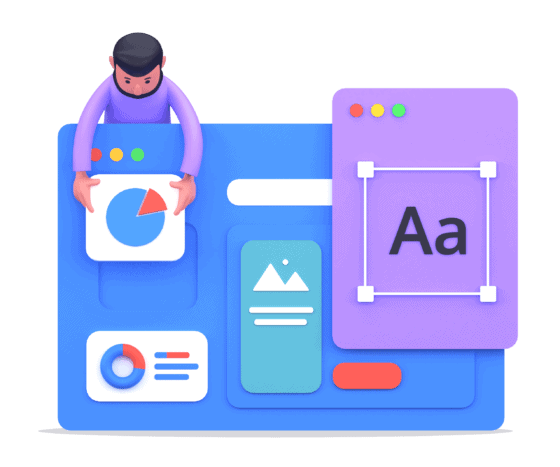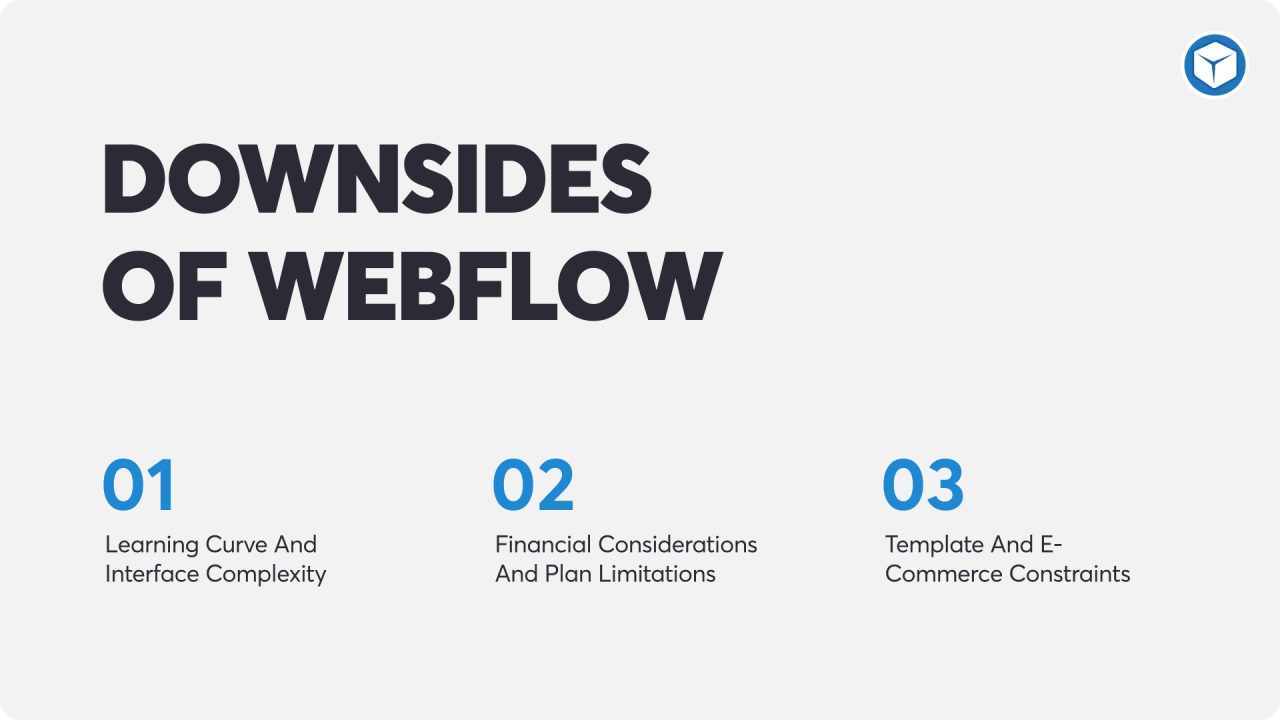
Webflow, a visual website-building platform, has gained attention for enabling everyday business owners to construct websites without coding knowledge. However, like similar ‘plug and play’ platforms, it presents certain limitations that can affect its usability for some users. Among these drawbacks, users find the platform’s learning curve notably steep, as mastering its comprehensive suite of design tools takes time and dedication. This can pose a challenge for time-poor business owners looking for quick website solutions.
Another sticking point is the cost of using Webflow. Although the platform offers a variety of plans, the pricing can be considerably higher than alternative solutions, such as WordPress, especially when factoring in the limitations on page numbers and site visitors. Although Webflow provides hosting services with high uptime and speed through Amazon CloudFront, these come at a premium and may not be suitable for businesses operating on a tight budget.
In terms of expansion and marketing, Webflow’s template selection is more limited and less diverse in comparison to the extensive library available on WordPress. This can restrict businesses from showcasing their unique brand identity through their websites. Additionally, while Webflow has incorporated tools to aid in search engine optimisation, its capabilities for content management and role customisation may not be powerful enough for larger organisations or those with intricate content strategies.
Key Takeaways
- Learning Curve and Interface Complexity – Webflow’s visual design approach, while innovative, comes with a significant learning curve that may not be suitable for individuals seeking immediate or simple website solutions. The interface offers a multitude of tools and settings, which can be overwhelming for beginners or those with limited tech savvy. A basic understanding of web development concepts, such as HTML and CSS, is also beneficial, indicating that while coding isn’t required, a foundational knowledge can enhance the use of Webflow’s capabilities. This steep learning curve could lead to longer onboarding times or the need for additional training resources.
- Financial Considerations and Plan Limitations – The financial implications of using Webflow are multifaceted. While the platform offers a free starter plan, it comes with significant limitations on page numbers and CMS items, and lacks a custom domain, which may prompt users to upgrade to paid plans that can reach up to AU$63 per month. This pricing structure can be restrictive, especially for small businesses or startups that need to scale their online presence quickly. Additionally, while Webflow’s hosting is known for its high uptime and speed, it comes at a premium cost that may not align with the budget constraints of smaller operations. The need to potentially hire experts for advanced customisation or to navigate the platform’s complexities adds to the financial considerations.
- Template and E-Commerce Constraints – Webflow’s template selection, though diverse, may not offer the breadth of design options or the level of customisation available on other platforms like WordPress, potentially limiting businesses in expressing their unique brand identity. The e-commerce features provided by Webflow, despite being functional, do not match the depth of dedicated e-commerce platforms such as Shopify, particularly in areas like the customisability of the checkout process and inventory management. This could pose challenges for businesses with more extensive product lines or those that require a highly tailored online shopping experience. The reliance on third-party apps for extending functionality can also introduce additional costs and complexity.
Table of Contents

Understanding The Webflow Website Learning Curve
Webflow offers a visual approach to website design that, while powerful, presents a learning curve for new users, particularly in understanding its interface and the web development concepts it incorporates.
Interface Complexity for Beginners
Webflow’s interface is comprehensive, providing a range of tools that enable deep customisation and control over website design. For individuals with little to no background in web design, the array of options and settings can be overwhelming. Familiarity with design concepts and the ability to visualise the end product are beneficial when starting out with Webflow.
Web Development Knowledge Requirement
Although Webflow is designed to allow designers to create websites without writing code, a basic understanding of web development principles can greatly benefit users. Knowledge of HTML, CSS, and basic design principles helps in creating more sophisticated sites. Users without this background may require additional time and resources to fully utilise Webflow’s capabilities.
Analysing Webflow’s Costs
Although Webflow positions itself as a ‘free’ CMS, it is important to keep in mind that what you get for free is more of a free trial than a usable website, and the costs can quickly add up as you look to add more functionality to your site.
Comparison to Other Website Builders
Webflow offers a range of pricing plans, with the Starter plan at AU$0 per month for users testing its features. Despite its cost-free entry point, the plan limits users to two pages and 50 CMS items without the benefit of using a custom domain. Comparatively, platforms like WordPress offer an open-source solution with more flexibility in terms of design and plugin integration, though often requiring additional investments in hosting services, themes, and custom development.
Impacts on Small Businesses
Small businesses must weigh initial investments in website construction against long-term scalability. While Webflow’s free version may appear financially approachable, restrictions like page and CMS item limits can necessitate upgrades sooner than expected. The investment climbs with paid tiers reaching up to AU$63 per month on general plans for increased limits. This financial trajectory can influence a small business’s website strategy, as the necessity for a custom domain and broader content capacity are usual as the business expands.
Businesses also need to factor in the investment of time and resources into learning the platform or hiring experts. Affordable entry-level costs can be advantageous initially, but subsequent scaling may lead to higher operational costs if frequent plan upgrades are required to accommodate growth.

Template Selection in Webflow
When exploring Webflow for website creation, the availability and adaptability of templates are two significant factors to consider.
Limited Aesthetic Options
Webflow provides a variety of templates, yet the selection may appear limited compared to other platforms. Users may find that the existing templates do not align perfectly with their desired aesthetic or brand identity. While there is some level of design flexibility within these templates, the constraints are evident in the absence of a broader range of styles and themes.
Budget Constraints for Bespoke Designs
Although Webflow templates offer a degree of customisation, achieving a completely distinctive design usually involves investing in higher-tier plans or hiring a designer, which might be beyond the budget of some users. This financial implication can limit those looking for a customised presence without substantial investment.
Webflow’s Marketing and Social Media Capabilities
While Webflow is celebrated for its design flexibility and customisation options, there are certain areas concerning marketing and social media where the platform may not fully meet user expectations.
Need for Third-party Tools
While Webflow supports basic SEO tools, such as meta titles and descriptions for pages, businesses could find the platform’s suite of marketing tools insufficient for more refined strategies. Users often rely on third-party integrations with platforms like GetResponse and Mailchimp for advanced email marketing services. For comprehensive analytics or marketing automation, external tools must also be connected to Webflow.
Complications in Website Management
The native features for social media integration could be perceived as basic, necessitating additional solutions to fully maximise social media engagement and tracking capabilities. Webflow’s CMS is deeply linked within its system, limiting how social media feeds can be displayed and interacted with on Webflow sites. Some users might find this integration less straightforward than preferred, potentially impacting how efficiently they manage their social media marketing efforts within the platform.
Exploring E-commerce Limitations in Webflow
Webflow’s e-commerce platform presents certain challenges that are especially evident when reviewed alongside dedicated systems and considering the operational impacts on a business.
Comparisons with Dedicated Platforms
When compared to leaders in the e-commerce sector, such as Shopify, Webflow shows limitations in its capabilities. Webflow’s e-commerce features, while functional, do not offer the same in-depth specialisation that a platform solely dedicated to online commerce might provide. Particularly, the checkout process in Webflow is not as deeply customisable as on some other platforms, where checkout can be finely tuned to match the retailer’s branding and specific workflow needs.
Operational Business Impacts
From an operational standpoint, inventory management in Webflow can present challenges. Its limited e-commerce capabilities mean that businesses with larger inventory or complex product offerings may find the platform restrictive. There is also often a reliance on third-party applications to extend the inventory capabilities of the system, which can lead to additional expenses and a potential patchwork of systems that businesses need to manage.
Move your existing website to a better platform – where you remain in control.
Ready to level up your online presence? Our tailored WordPress migration service can make it happen. Contact us to start your migration project.

Support and Assistance on Webflow
Webflow offers customer support systems. However, users have noted areas for improvement in the speed and real-time communication with support services.
Speed of Support Services
Webflow provides assistance through an email system, ensuring that users from around the globe can submit their enquiries. Despite being available, there are instances where the response times may not meet users’ immediate needs, especially when dealing with time-sensitive technical issues.
Real-time Communication Options
Real-time support options such as live chat are currently lacking. This means that for instantaneous communication, Webflow users might have to rely on community forums and existing resources, which while helpful, do not replace direct and prompt interaction with a support team member for resolving urgent technical matters.
Content Management and Role Customisation in Webflow
Webflow’s content management system (CMS) and ecommerce capabilities extend flexibility to users, but there are key aspects where limitations might be felt, such as role customisation and content management.
Collaboration Role Challenges
Webflow’s user role management does not offer deep granularity. This means that the capacity for creating roles with specific permissions can be limited, which might not suffice for larger teams needing tailored access controls. These restrictions could inhibit smooth team collaboration and workflow customisation, as each member’s ability to perform certain actions within the CMS relies heavily on the pre-defined role they are assigned.
Consequences of Non-reversible Actions
The absence of an ‘Undo’ button specifically for CMS and ecommerce actions in Webflow is a significant concern. Once an action, such as deleting an item or altering content, has been executed within the CMS or an ecommerce platform, reverting these changes can be difficult or sometimes impossible without prior revisions or backups.
These limitations demonstrate areas in Webflow’s content management and role customisation that may challenge users. The platform offers a powerful system for website development but expecting adjustments in user access and actions within the system to be easily reversible can lead to potential issues.

Detailed Constraints of Using Webflow
Webflow is a powerful design tool, but it has certain limitations that users may encounter when building and managing websites…
Offline Mode Absence
Webflow requires an internet connection to function, as it does not offer an offline mode. This restriction can impede the workflow of developers who need to work without reliable internet access or prefer to work offline due to various reasons such as travel or connectivity issues.
Issues with Transitioning Platforms
Exporting a site from Webflow has its limits. While users can export HTML, CSS, and JavaScript files, CMS content and server-side functionality cannot be exported. This hurdle trips over many business owners when they attempt to move a Webflow site to another hosting platform.
This is where Chillybin’s Website Migration service can really help business owners save a lot of time, money, and frustration.
Third-party Integration Limits
Webflow’s integration capabilities are impressive but not all-encompassing. Certain third-party services and tools may require custom code or are not natively supported, which could lead to an extended development time or increased reliance on external developers for integration.
Manual Multilingual Solutions
Multilingual support in Webflow is not automated, requiring manual setup for additional languages. This involves duplicating pages and manually translating content, which can be time-consuming for sites that aim to serve a diverse, global audience.
Site-Specific Security Limitations
The scale of password protection in Webflow is predominantly beneficial for small-scale projects. As a site grows and requires more refined user role management, the platform’s limited access control options may necessitate exploring alternative solutions.
By keeping these specific limitations in mind, users can more accurately assess Webflow’s fit for their website needs and plan for potential workarounds or consider other platforms if necessary.If you have decided that Webflow isn’t going to suit your business needs, we can help with website design and website development on WordPress. And if you have any questions about which platform will be best for your business, make sure you contact us today.